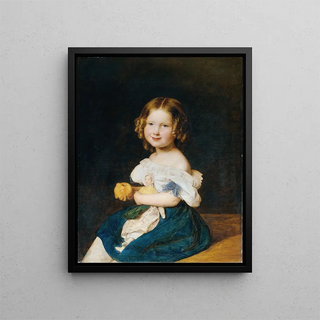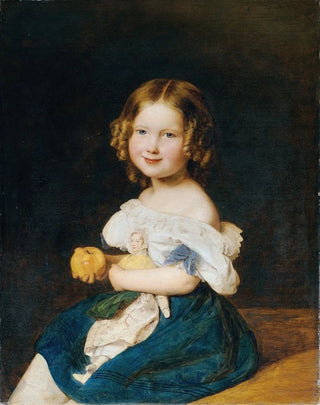Art print | Emilie Werner, the daughter of the married couple Johann and Magdalena Werner - Ferdinand Georg Waldmüller


View from behind

Frame (optional)
Emilie Werner Art print, daughter of the married couple Johann and Magdalena Werner - Ferdinand Georg Waldmüller – Captivating introduction
In the vast panorama of art history, certain works stand out for their ability to evoke deep emotions and capture the very essence of humanity. "Emilie Werner, daughter of the married couple Johann and Magdalena Werner" by Ferdinand Georg Waldmüller is undoubtedly one of these creations. This painting, unfolding with striking delicacy, immerses us in a moment of intimate family life, where tenderness and simplicity combine to create a work of unparalleled depth. Through Emilie's gaze, the viewer is invited to explore the nuances of human relationships and the subtleties of feelings that unite family members.
Style and uniqueness of the work
Waldmüller is renowned for his realistic approach and his ability to render light and textures in an unprecedented way. In this piece, he succeeds in capturing not only Emilie's face but also the warm atmosphere emanating from the scene. The choice of colors, ranging from soft and soothing tones to more vivid shades, creates a visual harmony that draws the eye and invites observation. Emilie's posture, both natural and composed, demonstrates the artist's mastery in depicting human figures. Every detail, from the subtle movement of her hair to the expression on her face, seems to tell a story— a story that transcends time and space to touch the hearts of those who contemplate it.
The artist and his influence
Ferdinand Georg Waldmüller, an emblematic figure of the Austrian Romantic movement, knew how to leave his mark on his era with his exceptional talent and innovative perspective on the world around him. Influenced by the social and cultural upheavals of his time, he integrated elements of everyday life into his works, making art accessible and close to human concerns. Waldmüller also played a key role in the development of portraiture as an artistic genre, emphasizing the psychology of characters and their environment. His style, combining realism and sensitivity, paved the way for many artists who followed in his footsteps, making

Matte finish

View from behind

Frame (optional)
Emilie Werner Art print, daughter of the married couple Johann and Magdalena Werner - Ferdinand Georg Waldmüller – Captivating introduction
In the vast panorama of art history, certain works stand out for their ability to evoke deep emotions and capture the very essence of humanity. "Emilie Werner, daughter of the married couple Johann and Magdalena Werner" by Ferdinand Georg Waldmüller is undoubtedly one of these creations. This painting, unfolding with striking delicacy, immerses us in a moment of intimate family life, where tenderness and simplicity combine to create a work of unparalleled depth. Through Emilie's gaze, the viewer is invited to explore the nuances of human relationships and the subtleties of feelings that unite family members.
Style and uniqueness of the work
Waldmüller is renowned for his realistic approach and his ability to render light and textures in an unprecedented way. In this piece, he succeeds in capturing not only Emilie's face but also the warm atmosphere emanating from the scene. The choice of colors, ranging from soft and soothing tones to more vivid shades, creates a visual harmony that draws the eye and invites observation. Emilie's posture, both natural and composed, demonstrates the artist's mastery in depicting human figures. Every detail, from the subtle movement of her hair to the expression on her face, seems to tell a story— a story that transcends time and space to touch the hearts of those who contemplate it.
The artist and his influence
Ferdinand Georg Waldmüller, an emblematic figure of the Austrian Romantic movement, knew how to leave his mark on his era with his exceptional talent and innovative perspective on the world around him. Influenced by the social and cultural upheavals of his time, he integrated elements of everyday life into his works, making art accessible and close to human concerns. Waldmüller also played a key role in the development of portraiture as an artistic genre, emphasizing the psychology of characters and their environment. His style, combining realism and sensitivity, paved the way for many artists who followed in his footsteps, making






